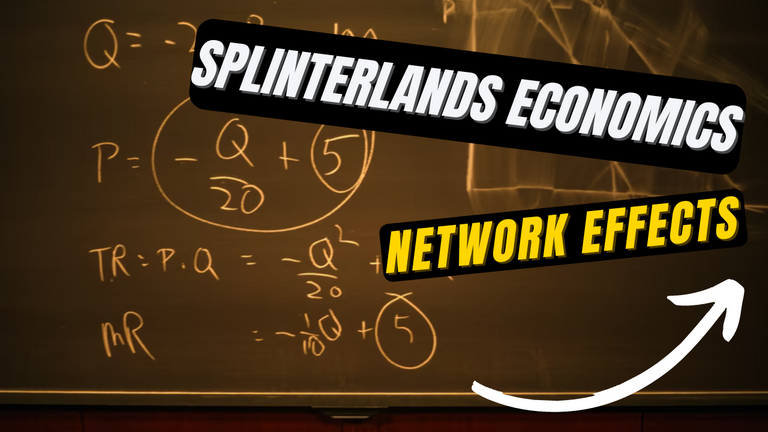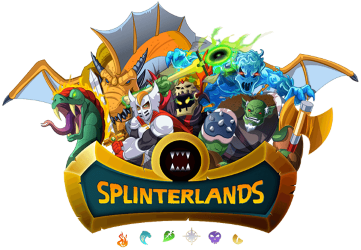Splinterlands Economics: Network Effects
Hello everyone! We are back again today with another edition of Splinterland Economics - a series in which we introduce a basic economic concept and then apply it to Splinterlands. If this is your first time reading, just to tell you a little bit about myself: my day job is in an unrelated area but I consider myself a little bit of economics nerd - I read a little (or maybe way, way) more news than I should, double majored in econ, and am obsessed with optimization. I love the way Splinterlands is equal parts card game and resource allocation game. My goal with these articles is to share a little bit of what I know with you all.
Our subject today is is one which has huge implications in the Hive ecosystem, as well as emerging technologies (NFTs, anyone?) and your favorite (or most hated) social media platforms. If you have been reading my articles for a while, this topic got a very brief mention in my post introducing externalities, and I think that it is a big enough concept for us to go back and take a deeper dive in. Today, we'll be talking about Network Effects!

What are Network Effects?

Network Effects are not quite the same as, but are very related to externalities. As I mentioned in the introduction to this post, I previously blogged about externalities and if you are curious about reading some more I would definitely recommend going back and checking out that article. But in case you forgot (or didn't know), externalities are an effect that does not directly affect the buyer or seller of a good. The term "network effect" is similar in that it specifically refers to a case where the value of a good or service changes in some way as more people use it. A good way to think about it is that network externalities can cause network effects. While it is possible for there to be negative network effects - for example, too many people using a particular service may cause it to become overcrowded or slower - network effects are most often positive, and today we are going to be spending most of our discussion on positive network effects.
One example of a network effect occurs when you purchase a cellphone. When you purchase a cellphone you can use it to call phone numbers (duh). If you are the only person you know who owns a cellphone then it still has some usefulness - you can use it to call any land line from wherever you are. However, if all of your friends and family also own a cellphone then your own cellphone becomes much more useful. In addition to calling everyone at home, you can also get in touch with them when they are out running errands, or are anywhere that has reception. Whether or not this is actually desirable is dependent on you and your contacts, but as more people purchase cellphones, the potential usefulness of each cellphone is expanded.

When it comes to networks, more people or nodes on a network result in more potential connections. And the number of connections can increase rapidly. For example, in a two person network there is only one possible connection. If you double that to four people, then there are four possible connections between those people - a 4x gain with just a 2x increase in the number of people! This is of particular importance when you are dealing with a network that is trying to maximize the connections or transactions that occur over the network - think of a social network like Facebook or a matchmaking website, for example.
How do we apply it to Splinterlands?

Splinterlands is a game with numerous examples of network effects, which is to say that as more players (or entities) are playing, then there are various aspects of the game which make it a more enjoyable experience. In nearly every area of the game, having more players participating brings some sort of benefits from the increased numbers.
As more players join ranked battles, you can find matches more quickly and with players closer to your skill and card level. When more cards are bought and sold in the game marketplaces it becomes easier to make new card purchases or sell cards you may not be using any more, making it possible to make desired changes to your collection more quickly. Greater participation in tournaments means larger tournaments, more battles to be played, and potentially greater winnings to be earned.
Social media is already an example of a network, so it should be no surprise that there are also network effects there when more Splinterlands players are active there. More players writing on Hive means that there will be more articles to read, (hopefully) higher quality posts rising to the top, and more upvotes for everyone. More people chatting about Splinterlands on Twitter, Facebook, or other social media both enriches discussions about the games and provides additional visibility and word of mouth to attract new players to the game. As evidenced by the weekly Social Media challenges organized by the Splinterlands team, the developers clearly value this last point!
Why should we care?

Understanding network effects allows us to better understand the actions developers take and how communities work. Network effects, both within the game itself and in the social networks outside of it, can quickly make Splinterlands more fun to play and more engaging to participate in the community.
When we hear in Town Halls about developers working on increasing code scalability and server capacity, those are great signs - not only because it means that the game website will run more smoothly, but also because it means that they are prepared (or are at least trying) to handle possible congestion or disruptions caused by more players, allowing the game to fully benefit from a larger community and greater network effects.
Are you participating in or building your own networks outside of Hive or Splinterlands? Knowing how network effects work can help you to take advantage of them, or to design ways to maximize them as people join the network - once you get that snowball rolling it tends to pick up speed faster than you might think!
Thank you so much for reading all the way to the end. Interested in seeing some more of my writing in the future? Be sure to give me a follow! In the meantime, if you'd like to see some of my recent posts:
Supply-ze Attack - Using Supply Runner in Battle! - Last week's battle challenge, featuring Supply Runner!
Splinterlands Economics: Anchoring - An introduction to anchoring, and how we can can apply it to Splinterlands.
Splinterlands Economics: Nudging - An introduction to nudging, and how we can can use it to our benefit in Splinterlands.
Thinking about giving Splinterlands a try but haven't signed up yet? Feel free to use my referral link: https://splinterlands.com?ref=bteim, and be sure to reach out to me if you have any questions!
All images used in this article are open source and obtained from Pixabay or Unsplash. Thumbnails borrowed with permission from the Splinterlands team or made in Canva.
Neat concept. We are kicking around an idea that involves networking in Splinterlands. The goal will be to help new players and attract new players, and it ties back to HIVE. I think the more we can strengthen the network, the more we will benefit.
Posted using Splintertalk
That sounds interesting, attracting and helping out new players is very important! Splinterlands is pretty cool in that it's running on Hive which provides a social network, and participating/interacting on Hive can help you to gain more in-game assets.
Nice post!
!PIZZA
Thank you! 😁
PIZZA Holders sent $PIZZA tips in this post's comments:
@eijibr(2/5) tipped @bteim (x1)
Learn more at https://hive.pizza.
I enjoy your economy series and how you apply these larger economic concepts and how they apply directly to Splinterlands and us. I'm always learning something new when I read one of your posts. Sharing this on https://twitter.com/PraetoriaDigest.
Thank you so much, glad you are liking it! 😄
Thanks for sharing! - @alokkumar121

nice post